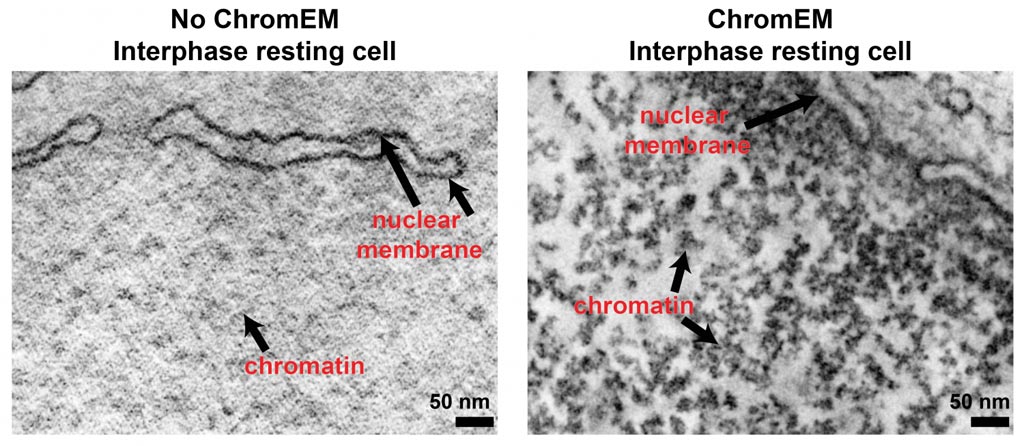Imaging Technique Reveals 3D Structure of DNA and Chromatin
By LabMedica International staff writers
Posted on 09 Aug 2017
Researchers have developed a method for visualizing the three-dimensional structure of chromatin, which explains how the two meter long molecular chain of genomic DNA fits inside the nuclei of human cells.Posted on 09 Aug 2017
Chromatin is a complex of macromolecules consisting of DNA, protein, and RNA. The primary functions of chromatin are to package DNA into a more compact, denser shape; to reinforce the DNA macromolecule to allow mitosis; to prevent DNA damage; and to control gene expression and DNA replication. Up to now there has been no method that enabled DNA and chromatin ultrastructure to be visualized and reconstructed unambiguously through the large three-dimensional volumes of intact cells.

Image: Chromatin structure determines the function of the human genome. To visualize chromatin within intact cells, a method called ChromEM stains DNA and paints chromatin with a metal dust. The metal-coated chromatin is imaged by electron microscopy to generate a three-dimensional volume that reveals chromatin structure and organization. A single slice from the three-dimensional volume is shown here. Detailed chromatin structures are seen in a ChromEM stained cell (right panel, dark structures), but not in an unstained cell (left panel) (Photo courtesy of Dr. Clodagh O\'Shea, Salk Institute for Biological Studies and Dr. Mark Ellisman, University of California, San Diego).
To visualize and reconstruct chromatin ultrastructure and three-dimensional organization, investigators at the University of California, San Diego (USA) and the Salk Institute for Biological Studies (La Jolla, CA, USA) developed ChromEMT, a method that combined electron microscopy tomography (EMT) with a labeling method (ChromEM) that selectivity enhanced the contrast of DNA. This technique exploited a fluorescent dye that bound to DNA, and upon excitation, catalyzed the deposition of diaminobenzidine polymers on the surface, enabling chromatin to be visualized with OsO4 in an EM (electron microscope). Advanced multi-tilt EMT revealed the chromatin ultrastructure and three-dimensional packing of DNA in both human interphase cells and mitotic chromosomes.
The investigators reported in the July 28, 2017, online edition of the journal Science that ChromEMT enabled the ultrastructure of individual chromatin chains, heterochromatin domains, and mitotic chromosomes to be resolved in serial slices and their three-dimensional organization to be visualized as a continuum through large nuclear volumes in situ. ChromEMT stained and detected 30-nanometer fibers in nuclei purified from hypotonically lysed chicken erythrocytes. Furthermore, the investigators showed that chromatin was a disordered five- to 24-nanometer-diameter curvilinear chain that was packed together at different three-dimensional concentration distributions in interphase and mitosis. Chromatin chains had many different particle arrangements and bent at various lengths to achieve structural compaction and high packing densities.
Senior author Dr. Clodagh O'Shea, an associate professor at the Salk Institute for Biological Studies, said, "The findings reveal that nucleus DNA assembles five to 24-nanometer-diameter chromatin chains in a diversity of three-dimensional conformations and motifs. In contrast to ordered and rigid fibers, chromatin is a flexible chain that can collapse and pack together into three-dimensional domains that have a wide range of different concentration densities. This provides exciting new insights into how different gene sequences, interactions and epigenetic modifications can be integrated at the level of chromatin structure to regulate gene expression and inherited and maintained through cell division."
Related Links:
University of California, San Diego
Salk Institute for Biological Studies













